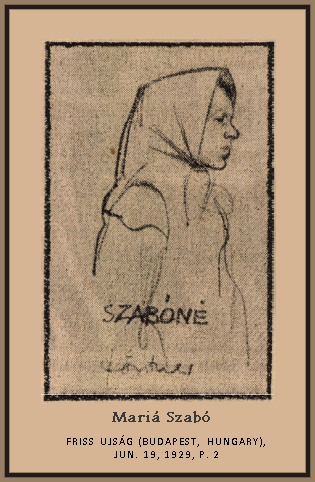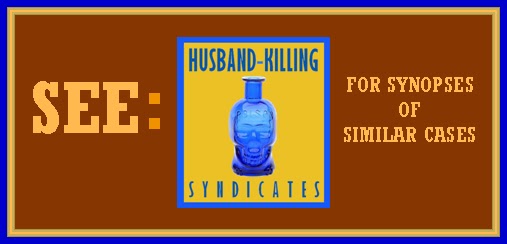They
were Ehthej Szabo and Christine Chordas, sentenced for poisoning Frau Szabo’s
father and uncle at Tiszakurt in March, 1925.
Both
fainted when they saw the gallows, and they were hanged simultaneously while
unconscious.
The
two women executed today were the second and third to die on the gallows in
Hungary within the past 50 years.
Sentence
was imposed on Estliej Szabo and Christine Chordas June 22 of last year, while
Joseph Madarasz and Laszlo Szabo were sentenced to life imprisonment in the
same case.
Altogether
34 persons were tried for the murder by poisoning of 42 others, the victims in
nearly all cases being husbands, brothers, fathers or mothers of the
defendants. Most of the crimes took place in the two neighboring villages of
Nagyrev and Tisznkuert. The poisoning in all cases was by arsenic and in at
least 20 cases it was supplied by the village midwife, Susie Olah, known as
“Aunt Susie.”
Women
were primarily responsible in virtually all the cases. The usual motive was
desire to get rid of men who had grown obnoxious because of drunkenness,
brutality, advancing years or other reasons. Virtually all the “peasant
borgias” took the view that they had not performed murder because they shed no
blood.
[“Women Pay in Ghastly Plot Of Killing 42 -
Hungarian Women Faint as They See Gallows and Are Hanged While Unconscious.”
Syndicated (UP), The Athens Messenger (Oh.), Jun. 17, 1931, p. 1]
***
The
backround:
EXCERPT
(Article 2 of 2): [T]he Widow Szabo, had offered to sell [a neighbor] poison
enough to kill him and show how to administer it—all for 120 penges (about $20)
down, 120 penges more after the funeral and a final installment of the same
amount when the estate had been settled up. Frau Szabo said she could guarantee
the poison would work without making the doctor suspicious because the had
tried it successfully on her own husband and brother.
The
precentor knew that his old friend Herr Szabo had gotten to be an invalid and
nuisance to his wife before his last and brief illness, but he was puzzled as
to why she had murdered her brother. It was later discovered that the brother
carried life insurance in his sister’s name and she needed the money.
Next morning without waiting for breakfast, the precentor
called upon the officer in command of the village s soldier-police force. That
night, after all the village was asleep, the police quietly took the widow
Szabo to the neighboring large town of Szolnok, where the police judge soon
drew the facts from her. She had, indeed, poisoned her husband and brother, and
gotten the stuff from another widow, Frau Zsuzsi Fazekas, the village midwife,
who was equally efficient at bringing people into the world or pushing them out
of it.
Frau
Fazekas was also arrested and brought to Szolnok for questioning. But, after
two days, when the judge had gotten no admissions from the iron-willed woman,
she was allowed to go home under the impression that she had bluffed the
authorities. Meanwhile, they had searched her house and found evidence of a murder
business, suggestive of Rome under the Borgias.
In
the attic of the house belonging to this woman, who was not a licensed midwife
though the best general nurse in either village, they found hidden away a large
supply of arsenic flypaper. Between the floor-boards of the attic and the
ceiling of the room below were a dozen pint bottles carefully corked and filled
with water, in which this same flypaper was soaking. The other bottles
contained the arsenic-saturated solution from which the papers had been
removed.
Taking
samples from the bottles and replacing the liquid they had removed with, an
equal amount of water, they left things so the woman would not suspect that her
poison hoard had been found. For two days after her return the poison merchant
stayed in her home as if nothing had happened, and then, as the authorities
hoped, curiosity began to burn her up. She just had to find out if someone had
talked and to caution all the other members how to act.
The
second evening after her return she set out on a round of calls. Every few
minutes her shawled head turned around that her sharp old eyes might assure her
that nobody was following. Nevertheless, she was shadowed most expertly and
every house she visited was noted. Also it was noted that in every case she
conversed with a woman who had been at least once a widow. On the next evening
her ringing of widows’ doorbells began and ended with that of Frau Szabo, the
precentor’s neighbor.
This
husband and brother killer had been returned to her own abode on the
understanding that if she would co-operate with the authorities, she would get
off easy. A detective was hidden within earshot when the nurse called, but
apparently some warning, perhaps involuntary, passed from the widow Szabo to
the widow Fazekas, for after a few perfunctory remarks about the weather, the
caller went straight home.
[Excerpt
from: “100 Self-Made Widows in One Jail – Husband Poisoners – Rumours of the
Wholesale ‘Removal’ of Unwanted Husbands Start the Authorities to Open Dozens of Graves in
the Village Church Yard at Nagyrev, Hungary, With Startling Results,” The
American Weekly (San Antonio Light) (Tx.), Nov. 24, 1929, p. 3]
For full text see:
“Zsuzsi Fazekas, Hungarian Serial Killer Leader of Serial Killers –1929”
***
***
***
***
***
***
***
For more than two dozen similar cases, dating from 1658 to 2011, see the summary list with links see: The Husband-Killing Syndicates
***
More cases: Female Serial Killers Executed
***
For more than two dozen similar cases, dating from 1658 to 2011, see the summary list with links see: The Husband-Killing Syndicates
***
More cases: Female Serial Killers Executed
***
[1890-1/13/21]
***









No comments:
Post a Comment